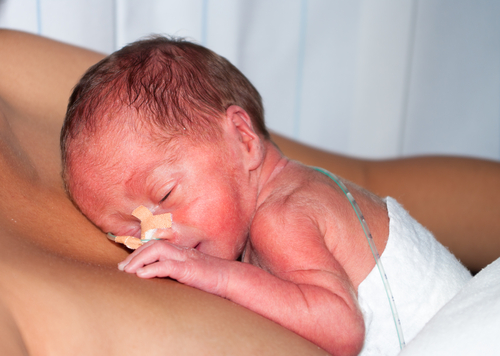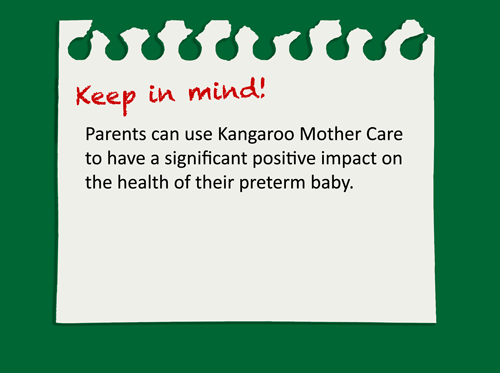Lesson 3: Infant family presence in the NICU
3.3 Parent-Infant Bonding: Kangaroo Mother Care
 The bonding between parents and their newborns usually can occur naturally after the birth of a healthy term infant. Bonding is more difficult when the newborn requires intensive medical care and monitoring. Parents often feel anxious, overwhelmed and helpless when their preterm baby is in the NICU. Much of the care of the baby is out of their control and physical contact between parents and child is constrained by medical equipment and treatment needs. Kangaroo Mother Care (KMC) is a technique used increasingly all over the world that empowers parents to assume a critically important role in the care of their premature infants.
The bonding between parents and their newborns usually can occur naturally after the birth of a healthy term infant. Bonding is more difficult when the newborn requires intensive medical care and monitoring. Parents often feel anxious, overwhelmed and helpless when their preterm baby is in the NICU. Much of the care of the baby is out of their control and physical contact between parents and child is constrained by medical equipment and treatment needs. Kangaroo Mother Care (KMC) is a technique used increasingly all over the world that empowers parents to assume a critically important role in the care of their premature infants.
KMC was introduced in the late 1970s by doctors at a maternal-infant hospital in Bogotá, Colombia. The technique was developed in response to limited availability of incubators for low birthweight infants and high rates of neonatal infections as well as frequent abandonment of these infants by their parents. Originally conceived as a way to foster parent-infant bonding and breastfeeding while using the parental body heat instead of an incubator, KMC is now promoted by the WHO (WHO et al. 2012) and has become a standard component of the neonatal intensive care of preterm infants in developing countries. As the numerous health benefits of KMC have become apparent, the use of KMC is expanding to NICUs in developed countries as well.
Just as the kangaroo mother cares for her immature offspring by holding them against her body with ready access to her milk, human parents are taught to hold their naked or mostly naked infants in skin-to-skin contact (SSC) against their chests. Expressed breastmilk is given, if available, until feeding at the breast can be introduced. The skin-to-skin contact can be intermittent or constant, sometimes depending on the stability of the infant or the availability of the parents. Fathers and other family members can assume a particularly important role in providing SSC.
The benefits of KMC for preterm infants and their families are measurable and impressive. A recent Cochrane review comparing KMC to standard neonatal intensive care concluded that KMC decreases mortality, severe sepsis or infection, hypothermia and length of hospital stay in preterm infants. At the same time, the technique leads to more weight gain in these infants and better breastfeeding rates. Finally, positive effects are seen on the infant's gain in head circumference, maternal satisfaction with the care method, maternal-infant bonding and the home environment (Conde-Agudelo & Diaz-Rossello 2014).
In this WHO video, a mother from Malawi describes the experience she had using KMC after her daughter was born preterm weighing only 820g.
Born Too Soon: Kangaroo Mother Care Saves Preterm Babies
